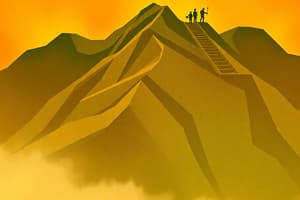Podcast
Questions and Answers
What characterizes Stage 1, traditional society?
What characterizes Stage 1, traditional society?
- Majority of workforce involved in primary sector (correct)
- Advanced technology usage
- Trade involves farmers and agricultural practices (correct)
- Mass production developed
What occurs in Stage 2, preconditions for take off?
What occurs in Stage 2, preconditions for take off?
Material conditions improve, businesses realize money-making opportunities, economy shifts from primary to secondary activities.
What is highlighted in Stage 3, takeoff stage?
What is highlighted in Stage 3, takeoff stage?
More companies involved in manufacturing, less subsistence farming.
What defines Stage 4, drive to maturity?
What defines Stage 4, drive to maturity?
What is the focus of Stage 5, age of mass consumption?
What is the focus of Stage 5, age of mass consumption?
What is the based principle in Rostow's model?
What is the based principle in Rostow's model?
Rostow's model assumes all countries will develop like Western economies.
Rostow's model assumes all countries will develop like Western economies.
What is Rostow's economic development model designed to describe?
What is Rostow's economic development model designed to describe?
What does deindustrialization refer to?
What does deindustrialization refer to?
Flashcards are hidden until you start studying
Study Notes
Rostow's Stages of Economic Growth Model
- Stage 1 (Traditional Society): Predominantly primary sector employment with mass production not yet established; agriculture is central to trade activities.
- Stage 2 (Preconditions for Take-Off): Improvements in infrastructure and transportation; businesses capitalize on money-making opportunities; economy transitions from primary to secondary sectors, leading to increased income.
- Stage 3 (Take-Off Stage): Manufacturing sectors grow, reducing reliance on subsistence farming; urban areas start to develop with concentrated growth in specific industries.
- Stage 4 (Drive to Maturity): Widespread integration of technology across all manufacturing sectors, enhancing productivity and efficiency.
- Stage 5 (Age of Mass Consumption): High levels of worker skill in various professions; productivity, earnings, and savings reach peak levels; economy shifts focus from secondary to tertiary sectors, with manufacturing centered on consumer goods.
Based Principle
- Emphasizes that consumers will save and invest wealth to enhance their economic status, providing essential capital for industry growth and generating returns for shareholders.
Critiques
- Assumes a linear progression of development similar to that of Western Europe and North America, which may not apply to all countries.
- Focuses on capitalist economies; many nations lack a robust capitalistic framework required for this model to be applicable.
Deindustrialization
- Older industrial cities face economic struggles due to a failure to transition from traditional industrial economies to innovative, entrepreneurial ones.
- Economic shifts have occurred as companies move operations from urban centers to suburban locations, impacting job availability and economic stability in those cities.
Studying That Suits You
Use AI to generate personalized quizzes and flashcards to suit your learning preferences.



